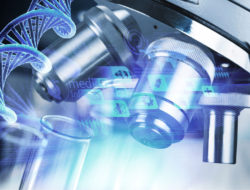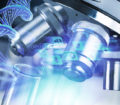What’s it like to be the CEO of the Smartest Company in the World? We didn’t have to travel far to find out. It’s a quick trip up to the UTC-area campus of genetic sequencing giant Illumina, where outgoing CEO Jay Flatley reflected on nearly two decades of leadership that took the company from 40 employees to 4,000, from very little revenue to more than $2 billion in earnings, and from a very small, niche scientific and medical research market to the boundless clinical space. That means regular people. We all now live in a world where knowing our genetic makeup, down to the individual chromosomes, is not only possible, but affordable. It will be soon be the norm. The data will detect cancer and disease early enough to cure it. Even prevent it. So when it took weeks to nail down time with Flatley, we had to understand. He, and his team, are literally curing cancer.
How on earth can you sequence a genome in 24 hours for just $1,000? How much science did it take to get there?
It took more than a decade, and $3 billion, to complete the Human Genome Project in 2003. In the ten years since that international effort, Illumina ingenuity made it possible to sequence a genome in about a day for $1,000. Illumina has invested over 3 million hours of labor in the sequencing-by-synthesis chemistry that underlies our next-generation sequencing systems, which leverage a huge collection of technologies—on the engineering side, mechanical, electrical, fluidics, optics, and software; and on the science side, biochemistry, surface chemistry, molecular biology, and bioinformatics—just to name a few.
What’s it like running a company that moves as fast as Illumina and exists in such a competitive industry as genomics?
The culture and the people are critical to our ability to stay competitive. We’re intentional and deliberate about supporting a culture where innovation, speed, openness to new ideas, and deep collaboration are rewarded. Working in such a dynamic environment is what makes work fun.
DNA sequencing can be applied beyond human disease. What are some ways we’ll be “slicing and dicing” DNA data in the future?
We see genomics playing an integral role in our food supply, forensics, and in scientific disciplines ranging from anthropology to zoology. Imagine the ability to enhance food availability by optimizing the way we grow crops to help provide nutrition to people in arid parts of the world. Or improving public safety with more robust ways to use DNA to solve crimes.
And for “regular” patients, how will their experience with doctors and hospitals change as a result of advances in genomics?
We believe that every baby will be sequenced at birth, and a person’s genomic information will be used to manage their health throughout their life. That day is coming sooner than many thought possible.
In reproductive health, noninvasive prenatal testing will become ubiquitous. All pregnant women will undergo this screening for identifying the risk of chromosomal abnormalities. For couples struggling to conceive, preimplantation genetic screening will be used in all IVF clinics to make sure that embryos are viable before they’re implanted.
The biggest change will be in cancer. Tumor samples will be routinely sequenced to guide treatment decisions. Five to ten years from now, we expect that a blood test for asymptomatic individuals will be available, enabling the detection of cancers in early stages, when they can be cured.
MIT Technology Review named Illumina the world’s smartest company in 2014. What does that mean to you?
Honestly, I was shocked. That recognition created a tremendous sense of pride within the company and to me personally. I’ve even been introduced to others as “the CEO of the smartest company in the world.” I think the title is a testament to us attracting the best innovators in the world, from engineering to informatics and manufacturing to marketing. It is hard to think of many other accolades that could be more meaningful.
From scientific discoveries to hostile takeover attempts, what moments stand out in your career?
The first was, of course, our initial public offering in July 2000. I had only been with the company for eight months, we only had 40 employees, and we were years from a product launch. Nonetheless, we had one of the most successful life science IPOs ever and raised $100 million.
Seeing the ways in which sequencing can help people has also been a source of great pride for me. I even had my own genome sequenced a few years ago and learned that I have a rare condition called malignant hyperthermia, which is associated with death under anesthesia. It’s a condition I otherwise wouldn’t have known about, but it’s important to be aware of should I ever need surgery.
The early phases of the takeover attempt from Roche seemed catastrophic at the time. While this ultimately turned out fine for Illumina, at the beginning no one believed we could survive as an independent entity—that it was “just a matter of price.” As a CEO, being told by most everyone that your company is going to be bought out from under you is tough news.
“We believe that every baby will be sequenced at birth, and a person’s genomic information will be used to manage their health throughout their life. That day is coming sooner than many thought possible.”
Is it true that 90 percent of the genetic data produced in the world comes from Illumina’s machines?
Yes. Illumina systems produce more than 90 percent of the bases sequenced in the world. Our customers have used our technology to do amazing science worldwide—science that has been featured in more than 30,000 publications.
Do you agree with the common comparison of Illumina to Google?
Illumina is a company focused on changing the world. In the sense that Google fosters a culture of collaboration to achieve innovation, we are similar. But Google is organized very differently than we are. I think we are more like Apple in our approach to our markets. Like Apple, we strive to always out-innovate ourselves, anticipate what products our customers need before they know they need them, and make our technology as simple as possible to use.
The human impact, helping people heal or find treatment, of genomics is real. What are some of the patient stories that inspire you?
In San Diego, rare-disease patients like Lily Grossman have benefited from being able to identify their diseases, seek treatments, and plan for the future.
Reproductive health is a huge source of inspiration, too. Many of our employees have conceived with help from Illumina technologies.
And then there is cancer. A paper in a July 2015 Journal of the American Medical Association highlighted the cases of ten women who’d been alerted to cancer diagnoses thanks to our noninvasive prenatal blood test. The light bulb went on, inspiring us to create the new company Grail. Its CEO, Jeff Huber, lost his wife to colon cancer last November. If Grail is successful in its mission to detect cancer early, when it can be cured, we will save millions of lives in patients who had no prior symptoms.
Does it matter that this company became what it is in San Diego, not Boston or San Francisco?
The mayor recently called San Diego “the genomics capital of the world,” and I think it’s true. Besides Illumina and Thermo Fisher, there are innovative health care systems, wonderful teaching hospitals, mobile health companies, world-class research institutions, and a robust software community. From Craig Venter to Eric Topol to Stephen Kingsmore, THE thought leaders in genomics are located here. Beyond genomics, UC San Diego graduates more engineering students than Stanford and Berkeley combined, and it and San Diego State get more research funding combined than any other two U.S. universities besides Harvard and MIT.
San Diego is often mischaracterized as laid back. We are just as competitive as our peers in Silicon Valley and Boston; we just happen to have beautiful beaches and great weather, too.
There is something special about the San Diego ecosystem, though. People are more collaborative. They want to be part of something bigger than themselves, and there are community groups like Connect and Biocom devoted to helping local companies do that. I don’t think you see that to the same extent in other hubs of innovation.
The Illumina Legacy
1998: Illumina is founded by a group of five venture capitalists and scientists
1999: After selling Molecular Dynamics for $300 million, Jay Flatley is recruited as CEO
2000: IPO raises $100 million
2001: Cost to sequence human genome: $100 million
2006: Illumina enters DNA sequencing; hires its 500th employee
2007: Acquires Solexa, developer of genomic-scale sequencing technology, for $600 million
2008: Cost to sequence human genome: $100,000
2009: Launches personal genome sequencing service for $48,000
2011: Relocates corporate headquarters to a bigger campus in UTC
2012: Swiss drug company Roche offers to buy Illumina for $6.7 billion. Shareholders decline.
2012: Cost to sequence human genome: $10,000
2013: Acquires Verinata Health, maker of prenatal blood tests, for $350 million
2014: Launches HiSeq X Ten, which sequences a human genome for $1,000
2015: Earns $2.2 billion in revenue
2016: Launches Grail, a new company for cancer screening, with $100 million in funding






























